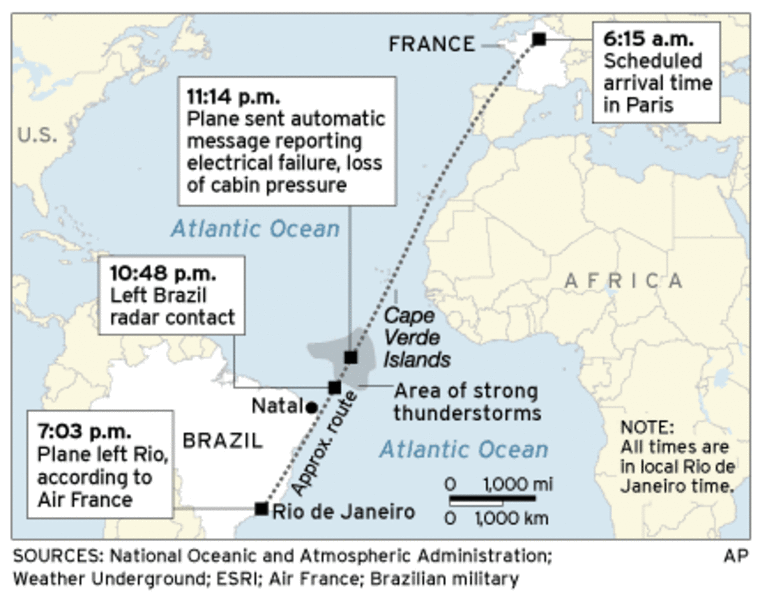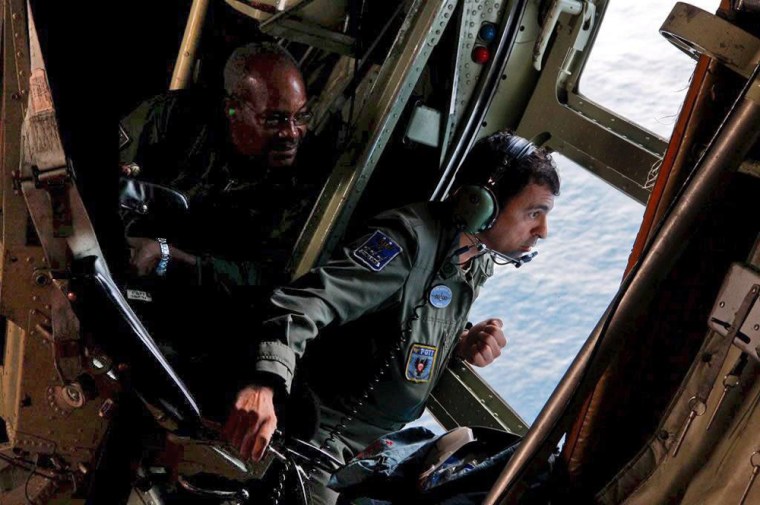Military planes located more debris from an Air France jet on Wednesday as the first navy ship arrived at the scene in the mid-Atlantic. But high seas and heavy winds slowed the recovery effort and delayed the arrival of crucial deep-water submersibles.
Search vessels from several nations pushed toward the floating debris, including a 23-foot chunk of plane and a 12-mile-long oil slick that Brazilian pilots spotted from the air. Rescuers have found no signs of life from the plane that was carrying 228 people from Rio de Janeiro to Paris, Air Force spokesman Col. Jorge Amaral said.
A Brazilian navy spokeswoman said a patrol boat was close to one debris field after spending two days pushing through rough weather to reach the site, but had not yet retrieved any wreckage.
A Navy frigate was expected to arrive later in the day, said the spokeswoman, who spoke on condition of anonymity in keeping with policy.
Flight 447 disappeared minutes after flying into an extremely dangerous band of storms Sunday night, but what exactly caused its electrical systems and cabin pressure to fail remains a mystery.
The "black box" cockpit recorders could be miles below the surface of the Atlantic Ocean. If they can't be recovered, investigators will have to focus on maintenance records and a burst of messages sent by the plane just before it disappeared.
French and Brazilian officials had already announced some details of these messages, but a more complete chronology was published Wednesday by Brazil's O Estado de S. Paulo newspaper, citing an unidentified Air France source, and was confirmed to The Associated Press by an aviation industry official with knowledge of the investigation.
Turbulent weather
The burst of automatic messages sent from the jetliner before it disappeared with 228 people on board suggests it probably broke apart in the skies and fell to the ocean in pieces, said the official, who isn't authorized to discuss details of the probe publicly.
The pilot sent a manual signal at 11 p.m. local time saying he was flying through an area of "CBs" — black, electrically charged cumulonimbus clouds that come with violent winds and lightning.
Satellite data has shown that towering thunderheads were sending 100 mph updraft winds into the jet's flight path just then.
Ten minutes later, a cascade of problems began: Automatic messages indicate the autopilot had disengaged, a key computer system had switched to alternative power, and controls needed to keep the plane stable had been damaged. An alarm sounded indicating the deterioration of flight systems.
Three minutes after that, more automatic messages reported the failure of systems to monitor air speed, altitude and direction. Control of the main flight computer and wing spoilers failed as well.
The last automatic message, at 11:14 p.m., indicated loss of cabin pressure and complete electrical failure — catastrophic events in a plane that was likely already plunging toward the ocean.
"This clearly looks like the story of the airplane coming apart," the airline industry official told the AP. "We just don't know why it did, but that is what the investigation will show."
Air France spokesman Nicolas Petteau referred questions about the report to the French accident investigation agency, BEA, whose spokesman Martine Del Bono wouldn't comment.
Brazil's Defense Minister Nelson Jobim also declined to comment on the report, saying "that investigation is being done by France, Brazil's only responsibility is to find and pick up the pieces."
Several media outlets reported Wednesday that an Air France flight from Argentina to Paris was delayed due to a bomb threat five days before the departure of ill-fated Flight 447 from Rio de Janeiro. According to the reports, the plane in question was inspected and nothing out of the ordinary was found before it departed for Paris 90 minutes late.
There was no reason to believe the incident was tied to the fate of Flight 447.
France's defense minister and the Pentagon have said there were no signs that terrorism was involved, and Jobim said "that possibility hasn't even been considered."

'Break up in the air'
The fierce thunderstorms, turbulence, lightning or a catastrophic combination of events could have broken apart the plane, aviation experts have said. And while the messages reported by the newspaper don't indicate why the aircraft went down, they strongly suggest it broke apart in the air, said Bill Voss, president and CEO of the Flight Safety Foundation in Alexandria, Va.
"These are telling us the story of the crash. They are not explaining what happened to cause the crash," Voss said. "This is the documentation of the seconds when control was lost and the aircraft started to break up in air."
Voss stressed that the messages alone were not enough to understand why the Air France jet went down, noting that the black boxes will have "far more parameters" that could determine the cause.
The new debris was discovered about 55 miles south of where searchers a day earlier found an airplane seat, a fuel slick, an orange life vest and pieces of white debris. The original debris was found roughly 400 miles northeast of the Fernando de Noronha islands off Brazil's northern coast, an area where the ocean floor drops as low as 22,950 feet below sea level.
Brazil was leading the search, while France took charge of the crash investigation, working with Air France, Airbus and meteorologists to determine what happened.
Brazilian divers were expected to arrive Thursday, but if the black boxes are at the bottom of the sea, their recovery will have to wait for the arrival early next week of a French research ship with remotely controlled submersibles that can explore as deeply as 19,600 feet.
Black boxes
The sturdy black boxes — voice and data recorders — are built to give off signals for at least 30 days, even underwater, and could keep their contents indefinitely.
But the head of France's accident investigation agency, Paul-Louis Arslanian, said in Paris that he is "not optimistic" about recovering the recorders — and that investigators should be prepared to continue the probe without them.
"It is not only deep, it is also mountainous," he said. "We might find ourselves blocked at some point by the lack of material elements."
A French AWACS radar plane and two other French military planes flew Wednesday over the area where debris was found to better narrow down the search zone. A U.S. Navy P-3C Orion surveillance plane — which can fly low over the ocean for 12 hours at a time and has radar and sonar designed to track submarines — also joined the operation.
Arslanian said investigators didn't have enough information to determine whether the plane broke up in the air or upon impact with the sea, and that in the absence of black box data, they are studying maintenance and other records.
"For the moment, there is no sign that would lead us to believe that the aircraft had a problem before it took off," Arslanian said.
He said investigators did not know the exact time of the accident or whether the chief pilot was at the controls when the plane went down. Pilots on long-haul flights often take turns at the controls to remain alert.
Lightning strike?
While some experts questioned whether a bolt of lightning alone could bring down an Airbus A330, Mary Schiavo, former inspector general for the U.S. National Transportation Safety Board, said it was plausible.
"For this plane, the difference could have been if the lightning hit a fuel tank or got inside and took out the electrical system," Schiavo said on CBS' "The Early Show. "It's like an atom bomb."
If no survivors are found, it would be the deadliest crash in Air France's history, and the world's worst civil aviation disaster since the November 2001 crash of an American Airlines jetliner in the New York City borough of Queens that killed 265 people.
Hundreds of relatives grieved deeply for those who were lost, a roster that included vacationers, business people, and an 11-year-old boy traveling alone back to England.
Brazil is holding three days of national mourning, and French President Nicolas Sarkozy was joining relatives at a service at Notre Dame Wednesday.
"We will miss your dancing feet," read a tribute from the Northern Ireland family of Eithne Walls, 29, a dancer-turned-doctor. "We will miss your silliness, your wit and your hugs. We will always hold you in our hearts and you are never truly gone."
